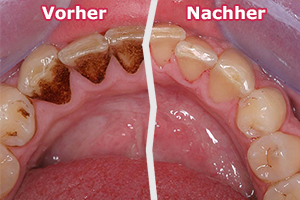Dental prophylaxis is another term for preventive care, a concept that is also familiar in other areas of medicine. However, in those cases people usually only go for preventive check-ups after a certain age. We have known for about 30 years that the majority of dental diseases are preventable. The root cause of almost all dental diseases is an excessively high number of certain bacteria, which secrete substances that burn holes in the teeth (caries) or which destroy healthy jaw bone and gum tissue (periodontitis). Technically speaking, the commonly used term "gum disease" is incorrect. In medicine, the ending "-itis" refers to the underlying inflammation. Receding gum tissue, deteriorating jaw bone and the resultant tooth loss are not caused by ageing. It's certainly true that some people are more immune to these bacteria than others; this is a genetic factor. However, this shouldn't be accepted as an excuse. The mouth's greatest enemy is inadequate oral hygiene.
The patient himself is largely responsible for preventing dental disease, i.e. by taking proper care of his mouth and teeth. Besides correct use of the manual or electronic toothbrush, cleaning between the teeth and the surfaces where the teeth meet is essential for a healthy mouth. This can be done with dental floss or an interstitial flossing brush. It is particularly important to clean your teeth AFTER meals so that the remains of your breakfast don't sit between your teeth during the day and your evening meal doesn't stay there overnight.
The dental team's task is to tell you which aids you need to clean your teeth as thoroughly as possible. Afterwards, the dental assistant will clean the areas that you can't keep sufficiently clean yourself. We scale your teeth using an ultrasonic instrument, while manual instruments are used to finish off in areas that are difficult to reach. The cleaned surfaces of the teeth are then polished using polishing paste - like toothpaste - and a rotary brush or similar. The Air-Flow powder jet device can remove severe discolouration such as that to which smokers and tea drinkers are prone. After being professionally cleaned, your teeth will be immaculate. They will then be treated with fluoride, unless this was already in the polishing paste. This hardens the outermost layer of the dental substance. The toothpaste you use at home should of course also contain fluoride. It is also advisable to use a fluoride gel once a week; this is brushed onto your teeth like a toothpaste, left for three minutes then rinsed out with water.
Our diet also has a major influence on the fate of our teeth. Their greatest enemy is the combination of sugar and acid, as sugar is optimum food for bacteria and acid creates an acidic environment in the mouth that stops the saliva from repelling bacteria. These four elements of dental prophylaxis - oral hygiene, professional cleaning at the dentist, fluoridation and a healthy diet - should become a lifelong routine. The belief that you don't have to use your toothbrush as often after a professional dental cleaning because everything has been put in order is wrong. Dental clinics should not be repair workshops. It's better to pay to avoid having your teeth drilled! The additional use of mouthwashes may be useful when undergoing dental treatment. They are also useful for patients who are unable to clean their teeth properly due to age or illness. However, it shouldn't be forgotten that the mouth is actually a biotope with a balanced population of microorganisms essential to our health. If you clean your teeth conscientiously, you shouldn't need any additional chemicals. Smokers are at a disadvantage with regard to the immune defences in their mouths. The substances in the smoke inhibit the blood circulation in the gums. This means that nutrients and antibodies cannot be transported into the tissue as effectively. The gum tissue of smokers therefore often looks less healthy than that of non-smokers. We offer a special mouthwash for smokers that helps protect their newly cleaned teeth from the deposits left by smoking. Everyone can find out how healthy their teeth are merely by taking a critical look in the mirror. Teeth and fillings have a light, even surface with no edges, cracks or discolouration. Healthy gum tissue is pink and firmly attached to the teeth. Bleeding gums are invariably a sign that something is wrong.
If the dentist can't offer any solutions, this means there's something wrong with the dentist!
Parking
Multi-storey car park
We offer parking places on the other side of the street next to the Kurpark.
Multi-storey car park
There is a multi-storey car park 100m away next to Königkarlstrasse 1 that you can use.
More details here Journey.





